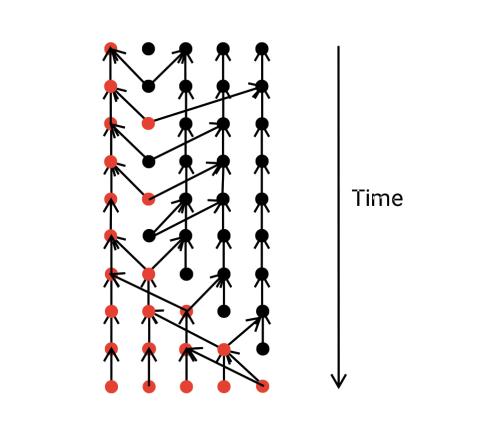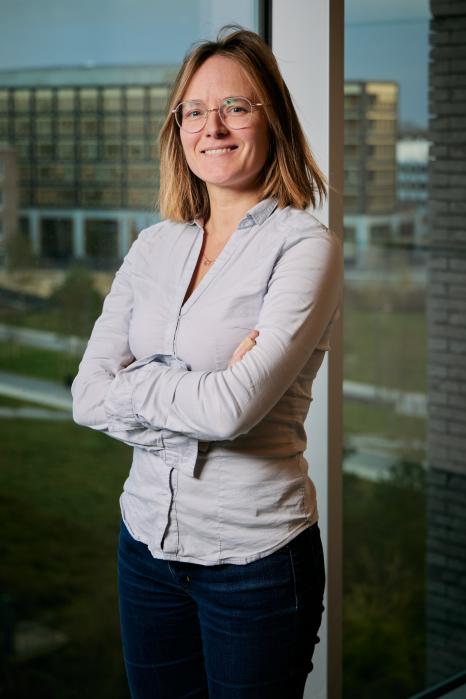
Camille Coron: a passion for applied mathematics
Camille Coron has been a Lecturer in Mathematics at Université Paris-Saclay and member of the Mathematics Laboratory of Orsay (LMO - Univ. Paris-Saclay, National Centre for Scientific Research CNRS) for nine years. In September 2023, she took on the role of INRAE Junior Professor at the Applied Mathematics and Informatics Laboratory - Paris-Saclay (MIA Paris-Saclay - Univ. Paris-Saclay, AgroParisTech, French National Research Institute for Agriculture, Food and Environment INRAE). As a mathematician, she is interested in probability and statistics applied to biology, particularly developing models for the genetics of biparental populations.
Camille Coron's daily life? Crunching numbers! This passion began in year 11 in secondary school, thanks to her mathematics teacher, who introduced her to the joy of mathematics and encouraged her to take part in the Kangaroo competition, where she excelled. Following the advice of her parents, both mathematicians, Camille Coron took a 2-year preparatory course at the Lycée Louis-le-Grand in Paris, after her baccalaureate. She then prepared for the ENS Paris-Saclay competitive exam, which she passed in 2006. Feeling somewhat bored with the mathematics taught on the preparatory courses, the young student abandoned the teaching qualification (agrégation) to focus on applied mathematics, which she discovered during her 2nd year master's at the Université Pierre et Marie Curie (now Sorbonne University). "We were doing applied mathematics in various fields, including biology and ecology, which I was already interested in at the time."
During this period, Camille Coron also developed an interest in research. She decided to pursue a doctoral thesis under the supervision of Sylvie Méléard at the Center for Applied Mathematics (CMAP) of the École Polytechnique. She successfully defended this in 2013. Following a post-doctorate within the Probabilities and Statistics team at the Mathematics Laboratory of Orsay (LMO), she was promoted to the post of Lecturer in this laboratory in 2014. In autumn 2023, INRAE recruited her for a three-year Junior Professorship Chair (CPJ) and she joined the Statistical Modelling and Learning for Environment and Life Sciences (SOLSTIS) team of the Applied Mathematics and Informatics Laboratory - Paris-Saclay (MIA Paris-Saclay). "If everything goes well, I'll eventually become an INRAE Research Director," the young researcher enthuses.
Birds, mosquitoes and air quality
Camille Coron's equations can model any subject. The mathematician also carries out computer simulations, which are a key asset in all her projects. "Above all, I need to like the subject! Preferably, it should be in the fields of biology, ecology or the environment. The core of my research activity is to develop mathematical models to answer an initial scientific question, in biology for example. I study the model and then compare it to the observed reality of that question, working with my biologist colleagues."
During her post-doctorate at the LMO, Camille Coron worked with Christophe Giraud to map the various bird populations in the Aquitaine Region. "The aim was to compare two very differently obtained datasets to produce the most reliable mapping possible of the different bird species."
In a similar approach, the mathematician is working with the National Institute of Applied Sciences (INSA) Rouen to create a detailed map of nitrogen dioxide concentration levels in the city's neighbourhoods. By combining real concentration measurements with physicochemical models, she aims to correct biases in these models due to certain overlooked factors or phenomena (such as variations in altitude, land use, etc.). "Since fine particles are very harmful, the goal is to alert the population if the tolerance threshold is exceeded."
Regulating mosquito populations is an equally important health issue in certain regions. One method of controlling harmful mosquito species involves releasing large numbers of sterile male mosquitoes - since male mosquitoes do not bite - to increase the number of female mosquitoes mating with these males. This is known as the Sterile Insect Technique (SIT). The resulting eggs are not viable, leading to a drastic reduction in the mosquito population. "I'm looking to calculate mathematical models that simulate this experimental protocol to identify the best way to apply it. Is it better to release the male mosquitoes daily or weekly? When and where will we need to restart the process?"
Genetics of biparental populations
Since her thesis, Camille Coron has also been interested in modelling biparental populations. "In many species, an individual has two parents. Its genome is therefore a random function of their genomes. If the individuals are diploid, meaning each gene is present in two copies in an individual, then one parent contributes one of these copies to their offspring and the other parent contributes the other copy. When studying biparental genetics, we are particularly interested in these two copies. This results in a complexity that is studied extensively from a biological perspective, but rarely from a mathematical one."
The mathematician is specifically interested in tracking the journey of a gene through a given population and is devising new models for this purpose. "I start with a gene in the present time to study its history, that is, its genealogy, not in the usual sense of tracing all the relatives in a ‘family tree’. I'm more interested in starting with the gene itself and studying its pathway through the pedigree, i.e. all the relationships between individuals."
Balancing mutation and selection
While the gene follows just one path, it will eventually be found in an individual. The same applies to another gene. "Whenever these two genes come together, they'll be together forever. So I'll have a single ancestor common to the whole population." Yet, there are alternatives that the mathematician is modelling. “I've demonstrated that half of all individuals are likely to contribute to the population as a whole, while the other half contribute to no one. In this case, the individual has no descendants over a long period of time." The mathematician is also interested in gene mutation phenomena. "This involves studying the balance between genome mutation and selection in a given population. For instance, we have observed the phenomenon of recurrent mutants. The question then becomes whether a better type of gene is found in a non-negligible proportion of the population."
Do maths!
For Camille Coron, her passion for mathematics remains as strong as ever. "I still remember the day I got my job as a lecturer. The 'wow' effect lasted several months," shares the woman who had never considered any other career path. "Even today, I wake up in the morning thinking that being a lecturer is fantastic. No other profession offers so much freedom: to choose what you work on and with whom." This is the first message that she imparts to her students, whether in commercialisation techniques at the Sceaux Technical Institute (IUT), where she has taught mathematics for nine years, or in the 2nd year Master’s degree in Mathematics for Life Sciences at Université Paris-Saclay, which she is currently directing. "Do maths" would be her second message. "Anyone with a passion for mathematics is bound to find something to their liking, because it opens doors to so many other disciplines and leads to a wide range of careers," concludes Camille Coron.

